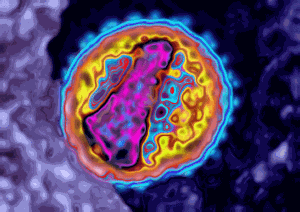
© JAMES CAVALLINI/SCIENCE PHOTO LIBRARYRNAi may have evolved to help cells fight viral infections.
Organisms including plants, fungi and flies fight viruses using an elegant mechanism involving RNA snippets that mammals apparently ditched at some point in their evolutionary history. At least, that is what scientists thought - but two controversial reports published today suggest otherwise.
The RNA defence mechanism hinges on the fact that most viruses copy their RNA when they replicate. Invaded cells recognize viral RNA and automatically launch RNA interference, or RNAi, to stop the virus from multiplying and spreading to other host cells.
The RNAi process begins when an enzyme known as DICER chops a long strand of the virus RNA into chunks that are about 22 genetic letters long. Next, another one of the host cell's molecules ships the fragments off to the invading virus where they cling to the viral RNA, preventing its replication.
"It's an incredible system because it can be adapted to any virus," says Olivier Voinnet, a molecular biologist at the Swiss Federal Institute of Technology in Zurich, Switzerland, and an author of one of the papers, which are published in
Science1, 2.
Over the past 15 years, scientists have looked hard for signs that this antiviral mechanism exists in mammals. They have sequenced the genetic content of cells from mice, humans and other mammals, but have come away empty-handed. They eventually postulated that mammals stopped using RNAi to fight viruses because they acquired a different defensive tool: toxic proteins called interferons. "The argument has been that interferons supplanted RNAi," Voinnet says, "So that's why the [RNAi] field has been frozen for mammals."
Strategic interferenceBut Voinnet and his colleague, Shou-Wei Ding, a molecular biologist at the University of California, Riverside, were not convinced. "We believe that RNAi has been antiviral for hundreds of millions of years," says Ding. "Why would we mammals dump such an effective defence?"
To investigate, Voinnet's team concentrated on embryonic stem cells from mice
1. Stem cells do not produce interferon proteins, so Voinnet reasoned that the cells would use RNAi to defend themselves instead. Indeed, he and his team recovered RNA fragments in the cells after infecting them with a virus. To show that DICER made the fragments, just as it does in other organisms, Voinnet deleted the gene for it - and the fragments were no more.
Meanwhile, Ding's team sought out RNAi in mice
2. He suspected that earlier studies had failed to find RNAi in mammals because the viruses that other scientists used contained proteins that destroy RNAi fragments. To avoid this, he infected 7-day-old mice with an obscure virus called Nodamura, because he knew how to block its defensive protein. Normally, the Nodamura virus kills mice, but when the team stripped it of its defence against RNAi, the virus died off and the mice survived. Ding says, "I truly believe that the RNAi response is relevant to at least some viruses that infect mammals."
Conflicting findingsBryan Cullen, a virologist at Duke University Medical Center in Durham, North Carolina, says that the authors may indeed have recovered antiviral RNA fragments from embryonic stem cells, but he thinks that their presence is likely to be irrelevant because "stem cells aren't the target of viruses". He and his colleagues have detected no signs of RNAi in mature mouse and human cells, despite using a highly sensitive sequencing approach that can recover RNA expressed at a level of just one copy for every 100 cells.
Virologist Ben tenOever at Icahn School of Medicine at Mount Sinai, New York, is also sceptical, saying that the data in the two papers are not robust enough to overturn the many studies that find no evidence for antiviral RNAi in mammals. For example, one study found that mice without interferon proteins died when infected with a flu virus that lacked a protein that blocks RNAi
3. "If RNAi existed," he says, "the mouse should have lived."
TenOever also thinks that Ding and his team made too many assumptions in their mouse experiments. The fact that the quantity of RNA fragments increased as the virus decreased is a correlation and does not prove causation, he says. He suggests that viral levels might have plummeted because the virus was damaged by the loss of its defensive protein, for reasons unrelated to RNAi. He also says that there is little evidence to indicate that the RNA fragments in the mice were created by the same RNAi machinery used in other organisms.
Although the authors disrupted DICER in stem cells, they did not perform the same experiment in cultured cells from the infected mouse. "It's frustrating," tenOever says, "the true proof of principle was not done." He says he plans on doing the DICER experiment immediately.
Voinnet says he expected that others would push back on his findings. "It's like people receive a punch, and then they need to think about what just happened," he says. But he welcomes the return of discussion in the field. "I hope people at least say RNAi may exist in mammals, and let's go for it."
Chris Sullivan, a virologist at the University of Texas at Austin, put a twist on the RNAi story while the
Science manuscripts were in press. In a report published on 26 September
4, he and his team found evidence that mammals activate their RNAi machinery when infected by viruses, but that the machinery is used instead to curb the interferon response, which can be toxic to the host.
Nature doi:10.1038/nature.2013.13600
Comment: For some food for thought see: On viral 'junk' DNA, a DNA-enhancing Ketogenic diet, and cometary kicks